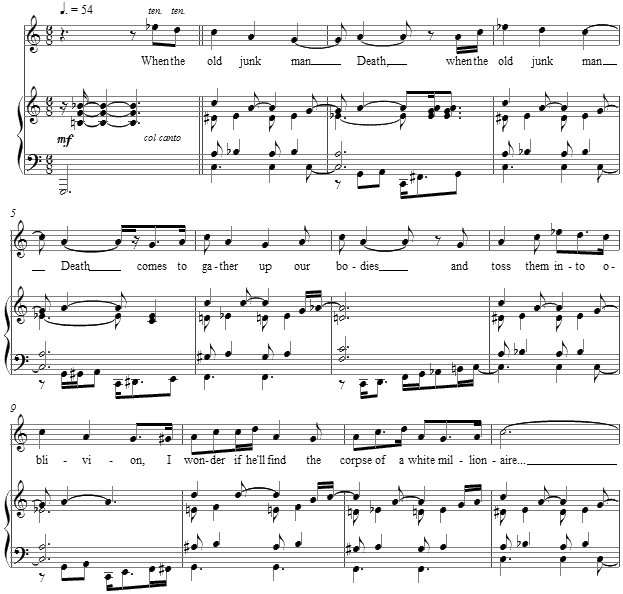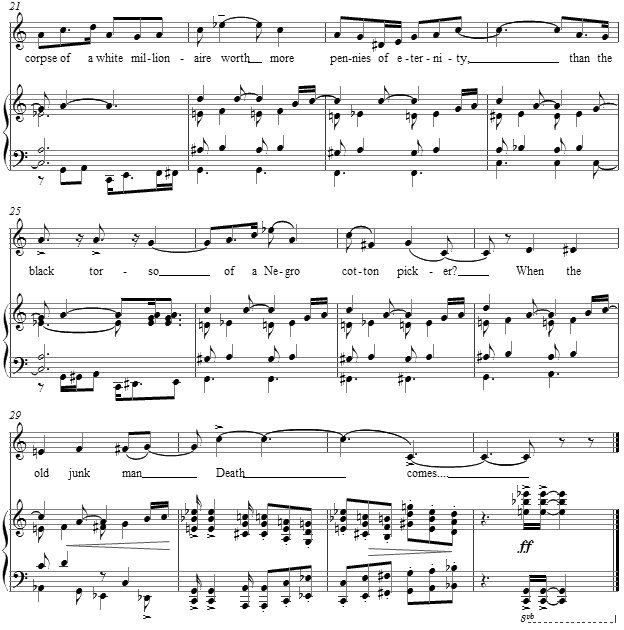Music and Texts of GARY BACHLUND
Vocal Music | Piano | Organ | Chamber Music | Orchestral | Articles and Commentary | Poems and Stories | Miscellany | FAQs
Question - (2008)
Langston Hughes
for medium voice and piano
When the old junk man Death
Comes to gather up our bodies
And toss them into the sack of oblivion,
I wonder if he will find
The corpse of a white multi-millionaire
Worth more pennies of eternity,
Than the black torso of
A Negro cotton-picker?
First published in Crisis (March 1922): 210, and included in Hughes' anthology The Weary Blues (New York: A. A. Knopf, 1926)
[ 2 pages, circa 1' 15" ]
Langston Hughes
Missouri-born Langston Hughes (1902-1967) grew up and was educated in Kansas and Ohio. He enrolled in Columbia University in New York in 1921, the year that he published "The Negro Speaks of Rivers" in Crisis, a journal which was edited by W. E. B. Du Bois, but then in 1923-24 worked as a seaman on trips to Africa and Europe. In April 1925 his poem "The Weary Blues" won first prize in a contest sponsored by Opportunity magazine. Alfred A. Knopf published Hughes' first book of poems, The Weary Blues collection, in 1926, establishing him him as a leader of the Harlem Renaissance.Hughes was a writer and playwright, opera librettist (Street Scene), editor, and historian. Among his books of poems are Fine Clothes to the Jew (1927), The Dream Keeper (1932), Shakespeare in Harlem (1942), Fields of Wonder (1947), One-way Ticket (1949), Montage of a Dream Deferred (1951), Ask your Mama: 12 Moods for Jazz (1961), and The Panther and the Lash: Poems of Our Times (1967). He received the Spingarn Medal in 1960, the highest honor awarded by the NAACP, and in 1961 was made a member in the National Institute of Arts and Letters. He wrote two autobiographies, The Big Sea (1940) and I Wonder as I Wander (1956). A supporter of other writers, from imprisoned Ezra Pound to Alice Walker, Hughes co-edited several important anthologies of black poetry, The Poetry of the Negro 1746-1949 (1949), and Poems from Black Africa, Ethiopia, and Other Countries (1963).
The poem makes a single statement across eight lines of unrhymed text. This "Question" presented a question as to how to set it, therefore. I chose to twist an almost standard 12-bar blues form its normal duple meter -- usually notated in 4/4 time -- into a 6/8, having the effect of truncating the expected four beat measure into two beats of a triple feeling, over which the occasional hemiola emphasizes the text against an underlying rhythm. In order to see this so, the text was therefore broken into two sections, with the introductory lines serving as the head motive (and coda) for each verse. The first faux verse ends with the text's fifth line, while the second verse takes up the text at that point after the textual theme of "the old junk man Death."
The coda to this two-strophe setting becomes more angular with a set of dropping diminished fifths before the reprise of the last image of "old junk man Death." A final set of chords betrays the sense of C major-minor for a moment before settling back to the final tonic tonality.
The score for Question is according to the text published in 1922 and is available for medium voice and piano as a free PDF download, though any major commercial performance or recording of the work is prohibited without prior arrangement with the composer. Click on the graphic below for this piano-vocal score.


